XTM vs Lokalise
AI that Lokalise can’t match
Built into XTM Cloud, our AI drives faster, higher-quality localisation—without the manual effort or vendor lock-in.

Book your personalised demo
Book your personalised demo
Best Lokalise alternative for AI translations
Lokalise handles basic app translation well enough. But when you need AI that actually thinks, quality controls that prevent disasters, and automation that scales with your business, XTM delivers what growing teams demand. Our AI doesn't just translate faster, it translates smarter.
Here are three reasons why XTM wins for localisation

Multi-LLM intelligence with quality scoring
XTM's SmartContext uses multiple large language models simultaneously, comparing results to select the best translation. Our Intelligent Scoring system evaluates every translation using industry-standard metrics. Lokalise offers basic machine translation without AI quality controls or confidence scoring.

AI compliance and risk management
Language Guard acts as your AI compliance firewall, screening content for risks before publication. Built-in safeguards protect your brand from AI-generated errors that could damage reputation. Lokalise lacks AI risk management or compliance features entirely.
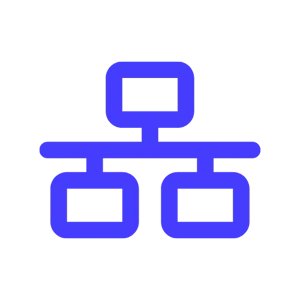
Intelligent workflow automation
XTM's AI makes routing decisions automatically based on quality confidence levels. High-scoring translations bypass review stages whilst uncertain content gets human attention. Lokalise uses static workflows without intelligent automation capabilities.
What's the difference between
XTM and Lokalise?
Both platforms handle translation management, but their AI capabilities couldn't be more different. Lokalise treats AI as a basic add-on — simple machine translation without quality controls, scoring, or intelligent automation. It works for teams that don't mind flying blind on translation quality.
XTM built AI into every part of the localisation pipeline. Our SmartContext technology doesn't just translate text — it understands context, maintains brand voice, and adapts to industry terminology. While Lokalise offers one-size-fits-all machine translation, XTM delivers AI that learns and improves with your content.
Here’s a side-by-side comparison of XTM and Lokalise for localisation
XTM vs Lokalise - AI translation quality
AI translation quality depends on more than just the underlying engines. Smart platforms use multiple approaches, quality scoring, and contextual understanding to deliver translations you'd actually publish.
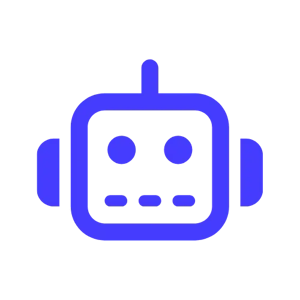
How Lokalise approaches AI quality
Lokalise connects to standard machine translation engines without additional quality controls. The platform provides basic AI translation for app strings but lacks sophisticated quality management. No confidence scoring, risk assessment, or intelligent quality gates. You get whatever the MT engine produces without enhancement or verification.

How XTM delivers intelligent AI quality
XTM's SmartContext technology uses multiple large language models simultaneously, comparing outputs to select the most accurate translation for each segment. Our AI doesn't just translate — it understands context, industry terminology, and brand voice requirements.
Intelligent Score system evaluates every AI translation using confidence metrics aligned with industry quality standards. This means you can set quality thresholds that automatically approve high-confidence translations whilst routing uncertain content for human review. Language Guard adds another layer by screening AI-generated content for compliance risks, offensive language, and brand inconsistencies.
XTM's AI quality features include:
- Multi-LLM comparison for optimal translation selection
- Confidence scoring with automated quality thresholds
- Brand voice consistency across all AI translations
- Compliance screening with risk management
- Learning algorithms that improve with your content
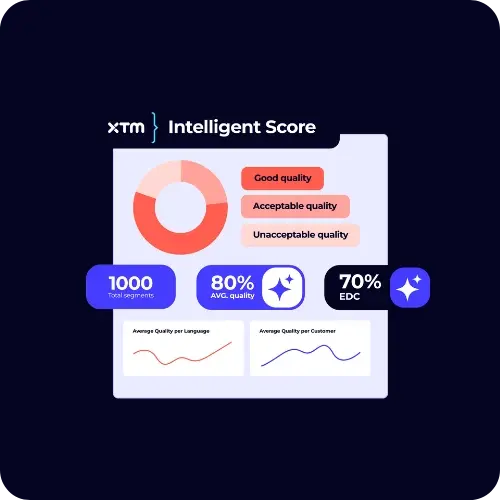
XTM vs Lokalise - AI workflow automation
AI workflow automation determines how intelligently your translation system can make decisions about routing, quality, and approval processes. Smart automation reduces manual work whilst maintaining quality standards.

How Lokalise handles workflow automation
Lokalise uses basic workflows designed for simple app localisation. The platform lacks AI-driven decision-making capabilities. Tasks move through static stages regardless of content complexity or quality levels. No intelligent routing based on AI confidence scores or automated quality gates.

How XTM's AI transforms workflows
XTM's Intelligent Workflow uses AI to make routing decisions automatically. High-confidence translations can bypass certain review stages, whilst complex content receives additional scrutiny. The system learns from your quality preferences and adapts routing decisions accordingly.
AI orchestration means workflows respond dynamically to content type, quality scores, and business rules. Project managers set up intelligent automation that handles routine decisions whilst escalating complex situations for human intervention.
XTM's AI workflow capabilities include:
- Intelligent routing based on AI confidence scores
- Automated quality gates with smart escalation
- Dynamic workflow adaptation based on content complexity
- Learning algorithms that improve routing decisions
- Risk-based automation for compliance-sensitive content
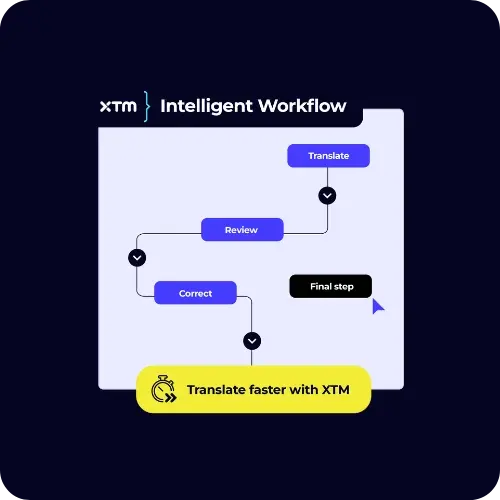
XTM vs Lokalise - AI compliance and security
AI compliance becomes critical when dealing with sensitive content, regulated industries, or brand protection requirements. The best platforms provide safeguards that prevent AI-related risks whilst maintaining translation quality.

How Lokalise addresses AI compliance
Lokalise offers basic machine translation without AI-specific compliance features. No content screening, risk assessment, or brand protection capabilities. Organisations must manually review all AI-generated content for compliance issues.

How XTM protects your AI-powered localisation
XTM's Language Guard technology acts as an AI compliance firewall, screening all AI-generated content before publication. The system detects potentially offensive language, brand inconsistencies, and compliance risks specific to your industry requirements.
Bring-your-own AI key support ensures data sovereignty for organisations with strict compliance requirements. Your translation data stays within your chosen AI provider whilst benefiting from XTM's intelligent quality controls and workflow automation.
XTM's AI compliance features include:
- Language Guard compliance screening and risk detection
- Bring-your-own AI key for data sovereignty
- Automated brand protection across AI translations
- Industry-specific compliance rules and content filtering
- Audit trails for all AI-powered translation decisions
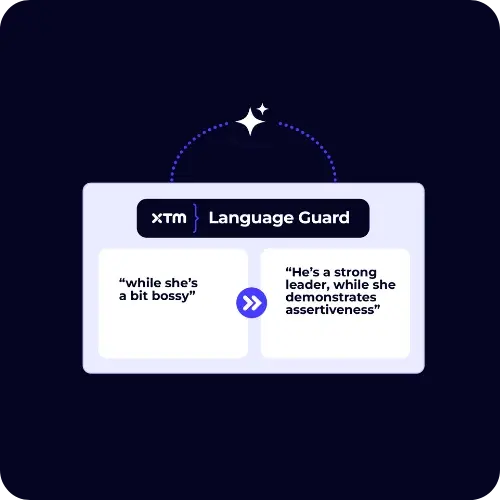
XTM vs Lokalise - Who wins for AI-powered localisation?
The choice depends on how seriously you take AI quality, compliance, and intelligent automation in your localisation workflows.
Advanced AI with enterprise controls
XTM delivers sophisticated AI capabilities that learn and adapt to your content requirements. SmartContext, Language Guard, and Intelligent Scoring work together as an integrated AI system. Lokalise treats AI as a basic feature without quality controls or risk management.
Intelligent automation that scales
XTM's AI makes workflow decisions automatically based on quality confidence and content complexity. This reduces manual project management whilst maintaining quality standards. Lokalise uses static workflows that require manual intervention regardless of AI quality levels.
Compliance and security for AI content
XTM provides enterprise-grade AI compliance with content screening, risk management, and data sovereignty options. Language Guard protects your brand from AI-related risks that could damage reputation. Lokalise lacks AI compliance features entirely.
Try XTM, the intelligent Lokalise alternative
Ready for AI translation that actually thinks? XTM delivers enterprise-grade AI with built-in quality control, compliance, and automation that adapts to your business.
Start your free trial or speak to our experts to see how XTM transforms localization with the intelligence and oversight global teams rely on.
Lokalise FAQs
What is Lokalise used for?
Lokalise is primarily used by software teams to manage and streamline the localisation process for digital products, especially web and mobile apps. The platform centralizes multilingual content, making it easier for developers, translators, product managers, and other team members to collaborate efficiently.
Lokalise helps simplify workflows, track translation progress, and ensure consistency across languages, significantly accelerating global product launches. However, for organisations requiring advanced AI-driven translations, compliance controls, and intelligent automation, platforms like XTM provide more robust and scalable solutions.
How does Lokalise work?
Lokalise works by centralizing multilingual content within a collaborative cloud-based platform. It enables teams—including translators, developers, and product managers—to manage translation projects in real-time, simplifying the localisation process for web and mobile applications.
Users can upload source files, track translation progress, edit strings collaboratively, and easily export translated content back into their projects. However, Lokalise relies primarily on basic machine translation engines and manual workflows.
Teams seeking advanced capabilities like contextual AI translation, dynamic quality control, intelligent automation, and comprehensive compliance safeguards often find XTM provides a more powerful and sophisticated approach to localisation.
How does XTM’s AI translation differ from Lokalise’s machine translation?
Lokalise uses standard machine translation engines suitable for basic app strings, offering straightforward translations without advanced context analysis or quality checks. XTM, on the other hand, employs sophisticated AI through multiple large language models (LLMs), comparing outputs to select optimal translations. XTM's AI understands context, adapts to industry-specific terminology, and maintains consistent brand voice, resulting in more accurate, high-quality translations.
Can Lokalise provide quality scoring and confidence levels like XTM does?
No—Lokalise does not include quality scoring or confidence assessments in its translation workflows. This means teams relying on Lokalise must manually verify translation quality, increasing risk and workload. Conversely, XTM’s Intelligent Scoring system automatically evaluates translations against established quality benchmarks, enabling users to set confidence thresholds that streamline reviews, boost translation accuracy, and accelerate the localisation process.
How does AI workflow automation in XTM differ from Lokalise’s workflows?
Lokalise employs static workflows that must be manually managed, regardless of content complexity or translation quality. This inflexibility can cause unnecessary bottlenecks and slow localisation processes. XTM’s AI workflow automation, by contrast, intelligently routes translations based on real-time quality confidence scores.
High-confidence content automatically bypasses unnecessary reviews, while uncertain translations are escalated for human intervention—delivering efficiency, accuracy, and scalable localisation.

Switching has never been easier — and the ROI starts immediately
Join 1,000+ brands that made the move and never looked back.


